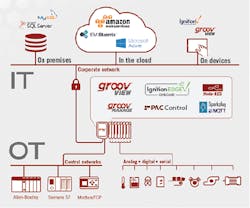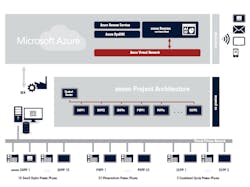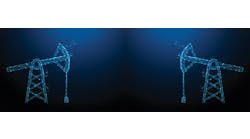It's always good to have more people and devices linked up and talking, whether it's over party lines, instant messaging, or the always-on Ethernet, wireless, cloud and the Industrial Internet of Things (IIoT). Simpler networking and the Internet in all its forms and formats are penetrating ever more widely and deeply into all areas of human endeavor, including manufacturing and industry, and they're bringing digitalization, virtualization and cloud computing along with them.
IIoT's teeth marks are everywhere, but what do all it's new players have to say? Well, Union Charter Township covers 28 square miles and serves 10,000 residents in central Michigan, and its Water & Sewer Dept. personnel formerly drove to each well, pumping station and treatment plant to gather flow rates, tank levels, pump statuses and other readings. When it migrated to less time-consuming remote monitoring, the department added remote desktop software to view and perform functions, but this forced it to maintain PCs running HMI software at each location, and they didn't interface with staffers' increasingly prevalent smart phones.
Because Union Township's water/sewer system had already used Opto 22 devices for more than 10 years, the department decided to deploy three of its groov Box appliances and software to build and use Internet-enabled HMIs more easily, and display equipment status, process measurements and other data (Figure 1).
Figure 1: IIoT solutions like Opto22's groov Edge Programmable Industrial Controller (EPIC)and its groov View HMI software and groov Manage software give users the tools to build interfaces and applications that can bring their control networks and devices together with their corporate networks more quickly and easily. Source: Opto22
“Considering the limited time we had between other projects, we were surprised we could get up and running so quickly with a new product,” says Shaun McBride, Union Township's chief water operator.
"For wastewater, we monitor flows, power consumption and tanks levels, as well as key metrics like dissolved oxygen, pH and turbidity," adds Michael Dearing, superintendent of Union Township's wastewater treatment plant. "groov was easy to configure and set up."
He and McBride report that they kept their existing PC-based HMIs, which continue to provide data for analysis, while their browser-based groov interfaces also run on tablet PCs and smart phones, which gives them the mobile support they need.
"We used to think that electrical engineering and process controls lived within the four walls of the plant, but now we can look further up and downstream, and control can go places it never could before," says Yves Dufort, principal consultant at Callisto Integration, a member of the Control System Integrators Association (CSIA) in Toronto, Ontario. "Binary signals are no longer confined to the manufacturing side's four walls and are spreading everywhere. This is why services like Amazon are investing living more in automation to perform their massive volume swings.
"Plus, in big industrial projects like steel mills that used to have huge amounts of wiring, users can now employ the IIoT stack to add little battery-powered devices and set up a wireless local area network (WLAN). All the old wires are gone, but users can start measuring different energy and production streams cheaply and efficiently without nedding to connect to traditional controls."
Clint Hommel, product marketing specialist for relays and monitoring at Phoenix Contact, adds: "When we talk about goals users have for IIoT, it's nearly always based on added monitoring of basic conditions, and then layering in common, reusable analytics. People are realizing they can address their isolated pillars of monitoring. We're seeing it in many projects, such as the rail heaters in New York City's subway system, which can now be monitored more closely for ambient conditions, turned on and off when it makes sense, and save about $20,000 per day."
Closer, quicker
It's easy to see that, just like in the old verbal message-passing game "telephone," the reach of the network is less crucial than achieving accurate communications and making sense of the input delivered. The IIoT aided by coalescing Ethernet protocols, data-translating software and microprocessors can get you there with fewer steps and hurdles, but you still need something understandable and useful to talk about when you arrive. In this case, bark may be more important than bite.
Peter Martin, vice president of business innovation and marketing at Schneider Electric, adds: "I look at the IIoT as technology reaching a point that its solutions aren't constrained, whereas PLCs and DCSs are constrained in how they can be applied in plants. The danger is that with so much technological advancement, no one is asking if they should. People are excited, but they're also distracted. We've reach an inflection point where we can stop talking so much about technology, and starting talking more about what problems to solve to make process applications and facilities run more profitably and safely. Many operators know what will happen to their process if they change a setpoint, but they don't know if doing it will create value for their organization or destroy it, so they often do what's comfy.
"This is why we need to move business contest down to operations, and give operators, engineers and maintenance more information to broaden process control strategies to include reliability, risk/safety, environment and profitability. These efforts can be helped by edge and connected devices, big data analytics on the plant floor and cloud-computing, and they're all enabled by IIoT if it removes old constraints and makes processes more effective. Schneider Electric's Profit Advisor, Control Advisor and Maintenance Advisor software look at operations in real-time, and allow different groups in a plant to collaborate and reduce the old schisms they used to have when their goals weren't aligned."
Ben Orchard, senior applications engineer at Opto 22, explains that: "Virtualization, mobile and cloud computing and IIoT are impacting process application designs by distributing applications, data processing and visualization to multiple devices and systems. Ethernet has allowed traditional control systems to de-centralize control schemes and HMIs, and more open and IT-compatible technologies will take this further, facilitating mobile-ready HMIs, data exchange with IIoT platforms for more advanced analytics and processing data at the edge using programming languages and tools more familiar to IT professionals and software developers.
"In the IT world, virtualizing computing, storage, servers, networking, etc. is well established, with benefits that include cost savings, reliability and performance improvements. The same will be true for process applications where real-time control, edge data processing, cloud analytics and mobile interfaces will improve performance, too. One of the primary gains will be savings by using more commercial off-the-shelf (COTS) technologies compared to vendor-specific, closed or siloed systems found in process applications. Also, because virtualization, cloud computing, IIoT and mobility in process applications involve operational technology (OT) and information technology (IT), it's important that both groups are involved from the start and work together."
Into the field, onto the edge
Because the IIoT is based on microprocessors running inside everything and on Ethernet networks running everywhere, it's also no surprise that it's quickly reaching down to sensors, analyzers, instruments and other device-level components, which used to be on the plant floor or in the field, but are now described as "at the edge."
For instance, Pioneer Energy is an oil- and gas services provider and OEM in Lakewood, Colo., that builds standard gas capture and processing units for tanks vapors and flare gas produced mainly at fields in North Dakota, Montana and Colorado.
Its VaporCatcher units capture hydrocarbon vapors from crude oil tank batteries and extract natural gas liquids (NGLs) at high yields, instead of sending these commodities to combustion or venting to atmosphere, which cuts emissions, meets EPA Quad O compliance standards and generates revenue. Likewise, its FlareCatcher equipment provides flare gas capture and processing at well sites, producing NGLs and pipeline-quality lean methane, and also enabling producers to achieve regulatory compliance (Figure 2).
Figure 2: Pioneer Energy's geographically dispersed FlareCatcher units produce natural gas liquids (NGL) and pipeline-quality methane from flare gas. Engineers at its Colorado headquarters monitor the units at remove well sites with Seeq's advanced analytics software, which optimizes data streams at the edge to focus on the most relevant data. Well site data processed by Seeq is accessible via a web serve and is available anywhere. Source: Pioneer Energy and Seeq
To keep track of its geographically dispersed units and analyze their performance to deliver continuous improvement, Pioneer must monitor and operate them from its Colorado headquarters over cellular or satellite connections, or use a local radio link that can relay each unit's information to a network hub. This information is also transmitted (at 1-second intervals for analog data and as it changes for discrete data) to one of two regional data centers in Denver or Dallas that have redundant power and networking services.
Beyond checking production, its engineers also monitor the units' onboard natural gas generator and auxiliary/backup batteries to maintain communications.
However, though Pioneer had field data coming to its data centers and could manually load data onto an Excel spreadsheet to calculate basic metrics, until recently, it had no sophisticated data analysis for handling complex calculations, and much of its data wasn't being utilized to its potential. After evaluating several software packages, Pioneer picked Seeq Corp.'s visual advanced analytics software, which includes a graph database, time-series optimization, browser-based interface, information sharing and visual pattern search tool.
Seeq enables Pioneer to optimize the data stream. They can define simple computations to be performed at the edge to determine what data needs to be streamed to its headquarters for analysis, and what data can be archived locally at the sites. Seeq's server resides at the secure data center, where it can access all field data. From there, the Seeq interface is made available via a web proxy server that lets Pioneer's staff access their data from anywhere.
"We're using Seeq to analyze and understand historical data, and generate and define new rules for operating parameters," says Andy Young, operations director at Pioneer Energy. "In a continuous improvement cycle, all data has potential value if it can be unlocked and leveraged. Seeq provides an environment for experimentation and learning, and its instant visual feedback is the appropriate way for engineers to analyze complex data in a reasonable amount of time.
"For instance, key components of Pioneer’s technologies are advanced refrigeration system designs that can be very sensitive to changing conditions. Seeq lets Pioneer isolate these effects, identify causes and develop simple operational rules to extend the life of our capital investment. If Seeq identifies a problem with equipment in the field, corrective action can be taken quickly. For example, Pioneer uses air-cooled cascade refrigeration systems, and during hot days, discharge temperatures and pressures can rise to elevated levels, leading to hardware failure. Detecting this with Seeq's advanced metrics and predictive analytics lets operators intervene and turn down system throughput until the condition clears. The single biggest outcome of the Seeq installation is improved operational intelligence."
Ira Sharp, product marketing manager for control, safety and I/O at Phoenix Contact, adds that: "IIoT doesn't just let us collect more information. It takes data off of clipboards, puts it into an electronic depository, and establish a single-screen dashboard that lets users make better-informed decisions about what they're producing, energy used, individual parameters or the whole facility. Fundamental operations may not be different than they were in the past, but IIoT can configure and combine them in more common ways for better overall returns. For instance, we just introduced PLCnext software for controllers and applications that connects directly to our Proficloud cloud-computing service. Users just check a few boxes, and immediately get data on process variables. It's a very flexible way for controllers using IEC 61131 code to reach IIoT via the cloud, and collect data from them."
Consumer/mainstream assist
Just as the IIoT is reaching down to devices on plant floor, many industrial users including process engineers are also finding themselves adopting IT-based strategies and mainstream computing services, such as Microsoft Azure or Amazon Web Services.
For example, electric utility GorenjskeElektrarne d.o.o. in Kranj, Slovenia, specializes in renewable hydroelectric and solar sources, but they're often in remote and difficult terrain that makes monitoring and control difficult, even though it's reduced costs and increased production with zenon HMI/SCADA software from Copa-Data for more than 10 years.
More recently, GorenjskeElektrarne sought to centralize monitoring and control of its 15 small hydroelectric power plants (SHPP), and connect 23 photovoltaic facilities to its central SCADA system. As a result, xenon was implemented to manage operating parameters, alerts and alarms and live video feeds to the utility's SHPP control center in Kranj, while zenon's Webserver Pro server and client let remote operators view this centralized data, diagnose events, and control their plants from anywhere with an Internet connection.
Unfortunately, despite its data access and performance gains, GorenjskeElektrarne still had some networking difficulties because its virtual private network (VPN) had to rely on Internet protocol (IP) over leased lines or unreliable satellite links. Consequently, the utility recently signed up to integrate its zenon SCADA system with Microsoft's Azure cloud platform and its Azure IoT Suite (Figure 3).
Figure 3: Operators and engineers at Slovenian electric utility Gorenjske Elektrarne use Copa-Data's zenon SCADA/HMI software to read PLC data and control 15 hydropower, 23 photovoltaic and three combined cycle plants, and recently integrated with Microsoft Azure cloud service to resolve networking issues with its former leased-line VPN and satellite links. Source: Gorenjske Elektrarne and Copa-Data
Gorenjske Elektrarne reports that Azure lets it deliver zenon's SCADA and control center visualization quickly and easily on mobile clients. Users simply install remote clients on their Internet-connected PCs, tablets PC or smart phones; securely access the zenon application with little initial investment and no specialized hardware; view a real-time dashboard of the utility's entire infrastructure of 36 distributed power generation sites; and respond to conditions and events and quickly as possible with more-informed decisions.
“This application is extremely fast and responsive" says Jurij Čadež, project manager at Gorenjske Elektrarne. "We're very happy with the outcome of our latest zenon project using Microsoft Azure as a platform. It's been very useful for us.”
Likewise, Sage Automation, a CSIA-certified system integrator in Adelaide, Australia, reports it's helping high-energy consumers such as water utilities, mines and manufacturers achieve reliable, cost-efficient energy mixes by using "distributed energy resources" and IoT.
“Traditionally, plants draw all their energy needs from the main power grid. But now, with a reduction in the cost of renewables, it’s more economically viable and reliable to bring in a mix of energy supplies onsite, such as backup diesel generators, hydropower and solar, which act as supplements to traditional power sources,” says Paul Moore, business development manager at Sage. “Central to a system like this is a smart control system that can accept and act on data in real time. This is where IoT comes into play. The system needs listen to sensor data at the process level and external information, such as weather reports, spot prices and scheduled/forecasted demands, and then decide which energy supply to draw on at what time.”
Sage can develop control system that learn how their plants work, identifies energy usage for independent processes through sub-metering, and then work out the most efficient way to run the plant's applications according to the available energy mix. “There's a big role for IoT in energy efficiency," adds Moore. "More and more, we’re applying open-source software, cloud-based services like AWS and COTS devices to solve new problems in new markets like energy and smart transportation.”
Equipment evolves—jobs, too
Though it can sound like hyperbole, IIoT's quick data access and shoving formerly separate network layers together are even altering the hardware and physical applications they serve—not to mention the job descriptions of their users.
"Energy efficiency comes from controlling plant-floor equipment, historian, IIoT devices and the network, and talking to the historian for asset management, maintenance and enterprise resource planning (ERP)," says Kareem Suhwail, power and energy group manager at RoviSys, which is a certified CSIA member in Aurora, Ohio. "Being able to easily connect and bridge these areas allows us to drive energy efficiency in new and dramatic ways. In general, better communication can enable double-digit or better percentage improvements in energy efficiency.
"In 2014, we worked on a steel mill with a powerhouse and boiler feed pump system, and the user wanted to compare the energy use of the boiler feed pump and steam usage to accurate commodity price data. We reconfigured the system, and added about $500,000 in equipment and engineering costs, including refurbishing its medium-voltage (MV) motors and adding new MV drives. Because these upgrades allowed more steam and electricity to be produce for the dame costs as before, they achieved ROI in 90 days, and continue to produce ongoing savings of $500,000 every three or four months."
In the future, Suhwail adds that IIoT and big data will also increase the use of modeling. "We have a user modeling a combined heat and power (CHP) plant, which can send setpoints to the control system based on pattern recognition and machine learning," he explains. "This is done by integrating Seeq's software on top of OSIsoft's PI software at the historian level. Instead of having engineers pore through data seeking trends and better ways to operate, Seeq helps identify that a pump's efficiency is in the toilet, so they can go fix it. The software is very proactive, and doesn't wait for something to break; it turns data into process intelligence, so users won't get big bills."
"We're very data driven with big data groups and historians with databases that can reach 1 million tags, so we pull data from everywhere for predictive analysis, machine learning and modeling. This is how advanced process control (APC) is moving into big data," says Suhwail. "We have clients in all industries with data centers worldwide and server farms, and they're comparing process performance in real-time with big data, and putting their smart devices on IIoT to secure trends, analysis, bad actors and proof of ROI."
Covina Irrigating Co. operates 12 sites that supply water to the Southern California city and parts of some neighboring towns, and its water distribution network, pumping plants, reservoirs and water treatment facilities employ Opto 22's controls to monitor and control their tanks, pumps, valves, filters and other equipment.
These devices usually communicate with a PC at its headquarters running Opto 22's PAC Display HMI software, which shows water levels, flow rates, pressures and equipment status. However, only one of Covina's remote operators could access the HMI at a time, and they needed a solution that would allow several to use it.
Consequently, Steve Sherman, Covina's field operations superintendent, added a groov Box at its main office, and built an interface to monitor and control the remote sites. The pumps, tanks and other equipment talk to groov Box as they did with the HMI PC—and it still provides information and logs for analysis—but now multiple operators can open web browser, log on securely to the groov interface using PCs, tablet PCs and smart phones, and monitor and control their devices and facilities.
Suhwail adds these shifts have pushed its own business more towards software, so it presently spends 75% on systems engineering and 25% on software engineering.
"Internally, most of our engineers are hybrids, but I also expected the EEs under me to be able to write Visual Basic applications and C++ if needed," he says. "We've had to become masters of both, and new graduates also need to know basic asset programming. This is because they have to design and write HMI packages, and do all the scripting that's needed behind the scenes. Engineers just have be even more like Swiss Army knives. There's no more 'throw it over the wall' to someone else. Some engineers that set up HMIs also do servers in virtual environments, program historians and PLC programs, and design enclosures—though we still ask panel shops to build them!"
Software everywhere—security, too
Logically, once its networks bring everything together and all those parts from the cloud to the edge are humming, that's when IIoT and its software applications can really being their collective power to bear. This can include applying more sophisticated algorithms and automation, or running artificial intelligence (AI), machine learning (ML) or other software-based tools.
For instance, Vijay Nathan, CEO and co-founder of Altizon Systems, reports that his company recently built an IIoT platform called Datonis that takes information from edge devices it's authorized to access; performs data aggregation and analysis at the platform layer; and exposes the resulting intelligence to users at the application layer performing productivity, quality, energy management or condition-based monitoring tasks.
"These projects begin with a cross-functional team and executive support, identifying technical impediments and running pilots, and scaling up to additional processes," says Nathan. "This captures a lot of data from critical infrastructure and edge devices, but software like Datonis means we can get a solution up and running in a few days where it used to take six months. We can also set up industrial data common areas to share insights. For example, we helped support www.watchyourpower.org in India, which provides power quality and availability data to 600 villages in India. These kinds of productivity as a service (PaaS) effort need a strong, IT-based platform to deliver their guaranteed outcomes. It's a lot of work, but system integrators and suppliers can partner to make it happen."
Similarly, software that used to run in boxes is now more free to run virtually where it's needed. "The pattern now is using software 'dockers and containers,' which are Google terms that reflect how virtualization of software is evolving," says Russ Agrusa, president and CEO of Iconics. "Old applications used to run on servers in data centers, but we've modified our code, too, so it can run as our Anyglass solution on an Android device or whichever mobile, IIoT or cloud device is preferred. Basically, a docker virtualizes a dynamic link library (DLL) that performs a function, and a container is a virtual set of DLLs than can run anywhere with help from HTML5 display capabilities and Javascript software."
However, once virtualization is performing on tablet PCs and smart phones, it can turn its attention back to the infrastructure to implement software-defined networking (SDN) and security policies for each device.
"Users can plug in a software-defined network switch, and enable its security rules, such as deep packet inspection, heuristic protocol detection as needed," says Tom VanNorman, systems engineering director, at Veracity Industrial Networks. "This isn't bolt-on anomaly detection, but instead gives users access through our software controller and application program interface (API), and shows them 100% views of their network. Ours is a deny-by-default network that only allows what users want to go over it. This means PLCs can't download changes until they're authenticated at the network layer, and once the network looks at everything, deep packet inspection characterizes all nodes, and policies can be applied to each. This lets the network know about everyone who's talking and protocol they're using."









